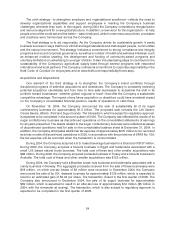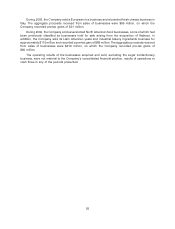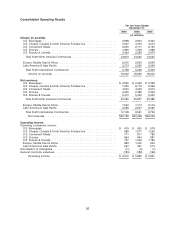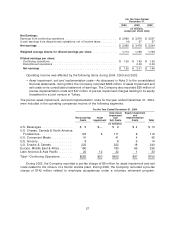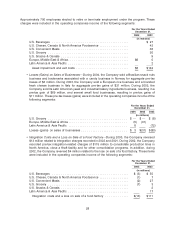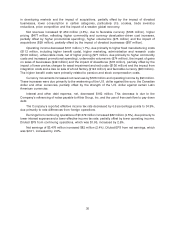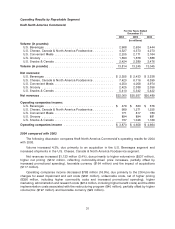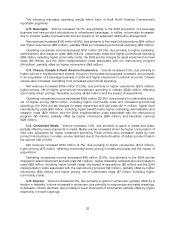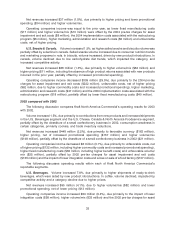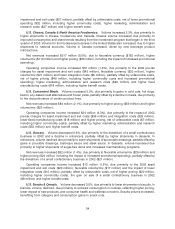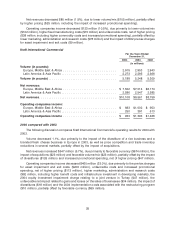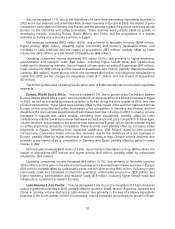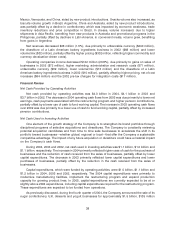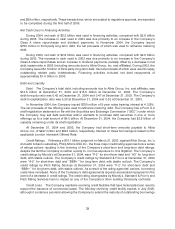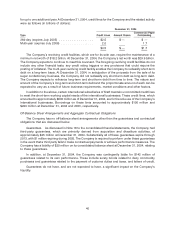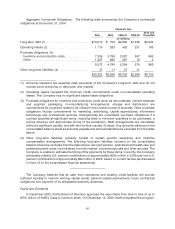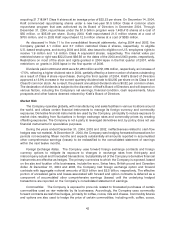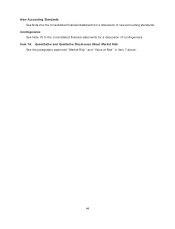Kraft 2004 Annual Report Download - page 35
Download and view the complete annual report
Please find page 35 of the 2004 Kraft annual report below. You can navigate through the pages in the report by either clicking on the pages listed below, or by using the keyword search tool below to find specific information within the annual report.impairment and exit costs ($27 million), partially offset by unfavorable costs, net of lower promotional
spending ($32 million, including higher commodity costs), higher marketing, administration and
research costs ($27 million) and higher benefit costs.
U.S. Cheese, Canada & North America Foodservice. Volume increased 2.3%, due primarily to
higher shipments in cheese, foodservice and Canada. Cheese volume increased due primarily to
improved consumption and share trends resulting from the investment program that began in the third
quarter of 2003. Volume for the foodservice business in the United States also increased, due to higher
shipments to national accounts. Volume in Canada increased, driven by new beverage product
introductions.
Net revenues increased $317 million (5.0%), due to favorable currency ($162 million), higher
volume/mix ($119 million) and higher pricing ($36 million, including the impact of increased promotional
spending).
Operating companies income increased $16 million (1.3%), due primarily to the 2002 pre-tax
charges for asset impairment and exit costs ($43 million), favorable currency ($32 million), higher
volume/mix ($21 million) and lower integration costs ($8 million), partially offset by unfavorable costs,
net of higher pricing ($49 million, including higher commodity costs and increased promotional
spending), higher marketing, administration and research costs ($20 million) and higher fixed
manufacturing costs ($18 million, including higher benefit costs).
U.S. Convenient Meals. Volume increased 0.3%, due primarily to gains in cold cuts, hot dogs,
bacon, soy-based meat alternatives and frozen pizza, partially offset by a decline in meals, due primarily
to the discontinuance of certain product lines.
Net revenues increased $84 million (2.1%), due primarily to higher pricing ($59 million) and higher
volume/mix ($23 million).
Operating companies income increased $34 million (4.3%), due primarily to the impact of 2002
pre-tax charges for asset impairment and exit costs ($36 million) and integration costs ($29 million),
lower fixed manufacturing costs ($18 million) and higher pricing, net of unfavorable costs ($7 million,
including higher commodity costs), partially offset by higher marketing, administration and research
costs ($53 million) and higher benefit costs.
U.S. Grocery. Volume decreased 0.6%, due primarily to the divestiture of a small confectionery
business in 2002 and a decline in enhancers, partially offset by higher shipments in desserts. In
enhancers, volume declined due primarily to lower shipments of spoonable dressings, partially offset by
gains in pourable dressings, barbeque sauce and steak sauce. In desserts, volume increased due
primarily to higher shipments of sugar-free items and increased merchandising programs.
Net revenues increased $32 million (1.4%), due primarily to favorable volume/mix ($29 million) and
higher pricing ($24 million, including the impact of increased promotional spending), partially offset by
the divestiture of a small confectionery business in 2002 ($21 million).
Operating companies income increased $13 million (1.5%), due primarily to the 2002 asset
impairment and exit costs ($20 million), favorable volume/mix ($17 million) and the impact of lower
integration costs ($10 million), partially offset by unfavorable costs, net of higher pricing ($20 million,
including higher commodity costs), the gain on sale of a small confectionery business in 2002
($8 million) and higher benefit costs.
U.S. Snacks & Cereals. Volume decreased 3.5%, due primarily to lower shipments in biscuits. In
biscuits, volume declined, due primarily to reduced consumption in cookies, reflecting higher pricing,
lower impact of new products, and consumer health and wellness concerns. Snacks volume increased,
benefiting from category and consumption gains in snack nuts.
34


